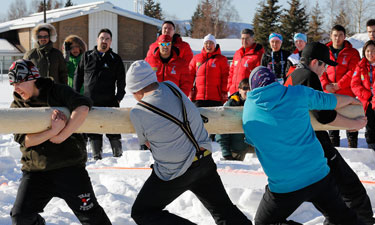 Two thousand athletes. Twenty different sports. Nine participating regions. Eight days of competition. The Olympics? Nope. This is the Arctic Winter Games (AWG), recently hosted in Fairbanks, Alaska, in part by the Fairbanks North Star Borough Parks and Recreation Department.
Two thousand athletes. Twenty different sports. Nine participating regions. Eight days of competition. The Olympics? Nope. This is the Arctic Winter Games (AWG), recently hosted in Fairbanks, Alaska, in part by the Fairbanks North Star Borough Parks and Recreation Department.
Showcasing a uniquely northern program of sports and culture, the Arctic Winter Games occurs every other year as a “celebration of athletic completion, culture, friendship and cooperation between northern contingents,” according to the event’s website. Serving as the world’s largest northern multisport and cultural event, the AWG enjoys a rich history of athletics and heritage that has provided athletes from around the Arctic Circle opportunities to compete, connect and share their traditions for almost 50 years.
The Arctic Winter Games began in 1969 when the province commissioners of the Yukon and Northwest Territories and the governor of Alaska met to address issues they saw with athletic competitions in their far-flung locales. Due to the distance between sporting communities, northern athletes and coaches had little access to competition, giving them a disadvantage when contending with other players who had more chances to test their skills against opponents. The first Games were held the following year, and three regions — Yukon, Northwest Territories and Alaska — participated in the inaugural event. Since then, athletes from Russia, Greenland, other Canadian provinces and the Sápmi region of Scandinavia have participated in the Games, which are held at locations rotating among Alaska, Canada and Greenland.
The Fairbanks North Star Borough has been preparing for this year’s event since it was awarded the 2014 Games by the Arctic Winter Games International Committee in February 2011. A board of directors consisting of 19 representatives from the greater Fairbanks area was convened, as well as a staff of 18 to coordinate the multifaceted event. Approximately 2,500 volunteers contributed to help carry out the Games, and an additional 3,000 or so family members and friends also showed up to lend their support. The Fairbanks North Star Borough Parks & Recreation Department, headed by Director Michael Bork, was central to the success of this year’s Games, the third time the community has hosted the event.
In addition to standard winter sports, such as ice skating, snowboarding, cross-country skiing and hockey, as well as year-round sports that include badminton, wrestling and gymnastics, AWG also incorporates traditional northern Arctic Sports and Dene Games. These categories draw from native customs and include events such as snowsnake, head pull, pole push and Alaskan high kick.
The Games also place a strong emphasis on cultural expression by the various participating groups, and during each biennial gathering, daily programs and activities are scheduled to reflect the unique heritage of each visiting team. Three to six cultural delegates and one designated artist from each participating contingent helped to provide performances and artwork in Fairbanks that showcased the customs and traditions of their homelands.
As the 2014 Games progressed, athletes aged 13 to 24 showed an impressive range of skill in sports and games ranging from dog mushing to basketball to knuckle hop. In the end, a total of 784 medals, known as “ulus,” were awarded — host team Alaska took home the most with 202. Perhaps more prized, however, is the Hodgson Trophy, a work of Inuit art carved from a six-foot narwhal tusk, decorated with scrimshaw and mounted on a soapstone base, which is awarded to the contingent whose athletes best represent the Games’ unifying ideals of fair play and team spirit. This year, Team Greenland won the coveted award for their exemplary demonstrations of good sportsmanship, friendship and cooperation during their participation throughout the Games.
“The Games were fantastic!” says Bork. “No major issues, [and] the weather was optimal. One innovative thing that was unique this year was the creation of an AWG app for smartphones and tablets, and the heavy use of social media. On the app, you could look at sport schedules, bus schedules, results, medal counts, etc. It was very popular and well-used. The social media blitz was phenomenal and was a highlight of the games.”
“The Arctic Winter Games offers young people around the north what might be their only opportunity to have such a rich and intense sport and cultural experience,” says John Estle, owner/operator of SportAlaska and 2014 AWG board member. “Having participated in several Olympic Games, I can vouch that for the fact that the AWG experience has a greater impact upon the lives of many of the athletes and cultural representatives than does the Olympic Games on Olympic participants.”
Danielle Taylor is the Senior Editor of Parks & Recreation Magazine.

